通用版小学英语小升初复习03形容词副词专项讲练课件(共22张PPT)
文档属性
| 名称 | 通用版小学英语小升初复习03形容词副词专项讲练课件(共22张PPT) |  | |
| 格式 | pptx | ||
| 文件大小 | 1008.1KB | ||
| 资源类型 | 试卷 | ||
| 版本资源 | 通用版 | ||
| 科目 | 英语 | ||
| 更新时间 | 2023-05-08 11:25:41 | ||
图片预览

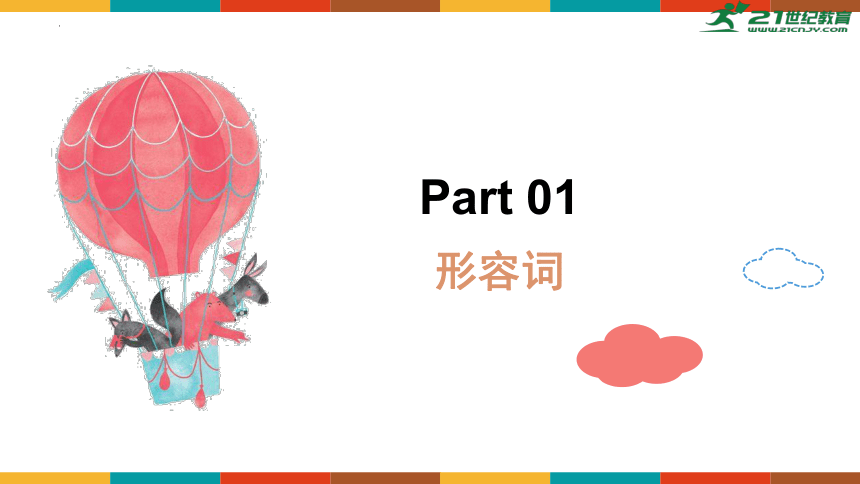
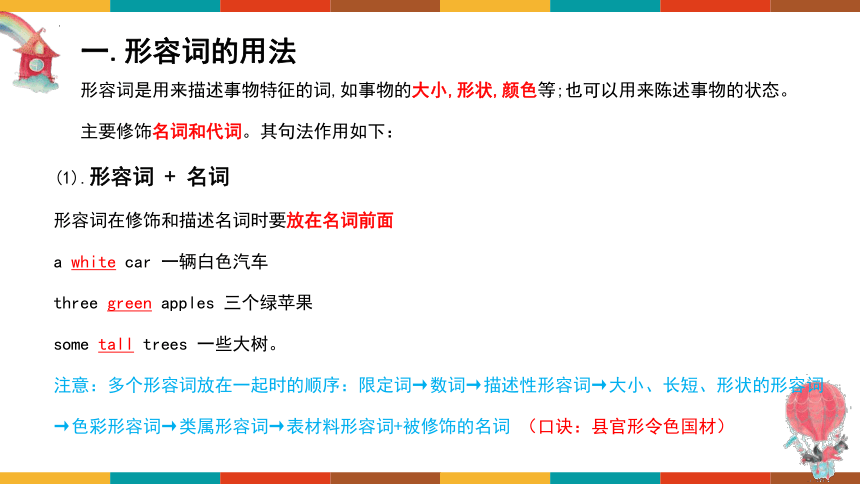
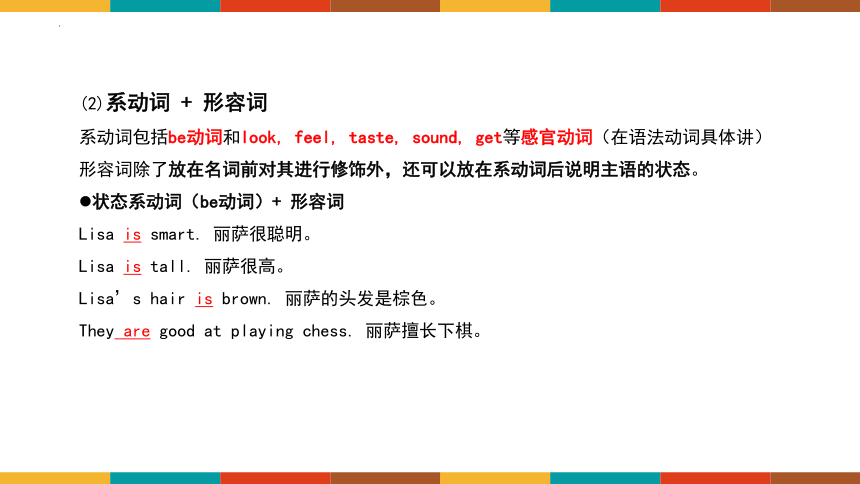
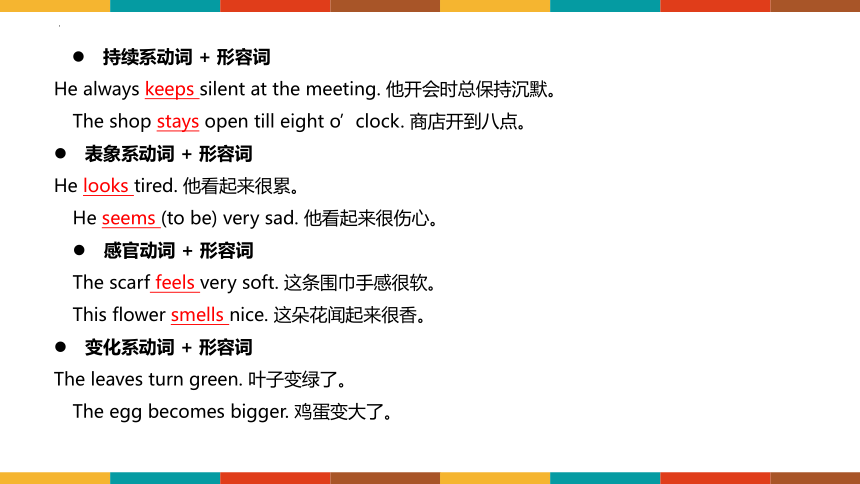
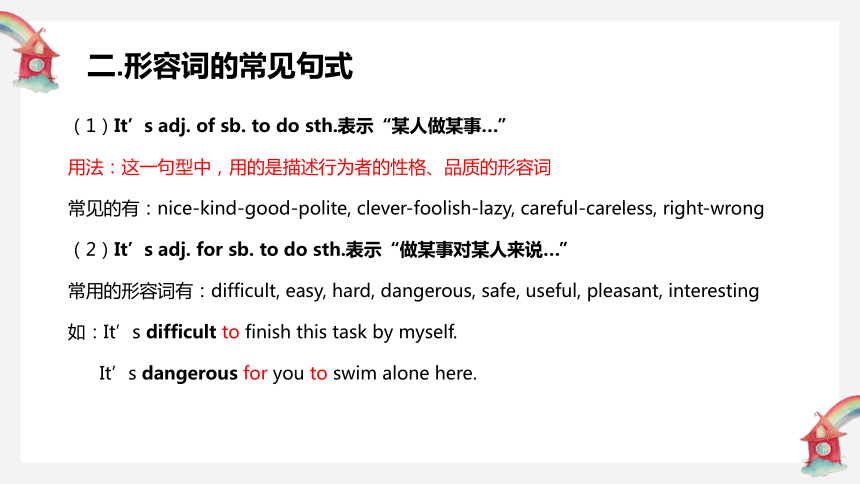


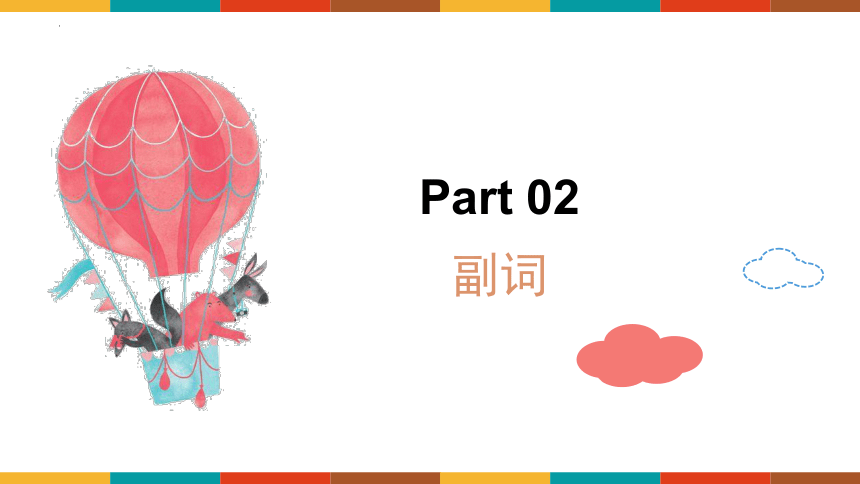
文档简介
(共22张PPT)
小升初总复习语法
形容词/副词
形容词
Part 01
形容词是用来描述事物特征的词,如事物的大小,形状,颜色等;也可以用来陈述事物的状态。
主要修饰名词和代词。其句法作用如下:
(1).形容词 + 名词
形容词在修饰和描述名词时要放在名词前面
a white car 一辆白色汽车
three green apples 三个绿苹果
some tall trees 一些大树。
注意:多个形容词放在一起时的顺序:限定词→数词→描述性形容词→大小、长短、形状的形容词
→色彩形容词→类属形容词→表材料形容词+被修饰的名词 (口诀:县官形令色国材)
一.形容词的用法
(2)系动词 + 形容词
系动词包括be动词和look, feel, taste, sound, get等感官动词(在语法动词具体讲)形容词除了放在名词前对其进行修饰外,还可以放在系动词后说明主语的状态。
l状态系动词(be动词)+ 形容词
Lisa is smart. 丽萨很聪明。
Lisa is tall. 丽萨很高。
Lisa’s hair is brown. 丽萨的头发是棕色。
They are good at playing chess. 丽萨擅长下棋。
l 持续系动词 + 形容词
He always keeps silent at the meeting. 他开会时总保持沉默。
The shop stays open till eight o’clock. 商店开到八点。
l 表象系动词 + 形容词
He looks tired. 他看起来很累。
He seems (to be) very sad. 他看起来很伤心。
l 感官动词 + 形容词
The scarf feels very soft. 这条围巾手感很软。
This flower smells nice. 这朵花闻起来很香。
l 变化系动词 + 形容词
The leaves turn green. 叶子变绿了。
The egg becomes bigger. 鸡蛋变大了。
二.形容词的常见句式
(1)It’s adj. of sb. to do sth.表示“某人做某事…”
用法:这一句型中,用的是描述行为者的性格、品质的形容词
常见的有:nice-kind-good-polite, clever-foolish-lazy, careful-careless, right-wrong
(2)It’s adj. for sb. to do sth.表示“做某事对某人来说…”
常用的形容词有:difficult, easy, hard, dangerous, safe, useful, pleasant, interesting
如:It’s difficult to finish this task by myself.
It’s dangerous for you to swim alone here.
拓展知识
形容词的比较级和最高级变化形式规则如下
规则 原级 比较级 最高级
单音节词和部分双音节词 大多数词后加er或est tall small taller smaller (the) tallest (the) smallest
以字母e结尾的词后加r或st nice fine nicer finer (the) nicest (the) finest
以一个辅音字母结尾的重读闭音节,双写尾字母,再加er或est slim big fat slimmer bigger fatter (the) slimmest
(the) biggest
(the) fattest
以“辅音字母+y”结尾的词,去掉y,再加ier或iest prettyeasy prettier easier (the) prettiest
(the) easiest
多音节词和部分双音节词 在词的前面加more或most beautiful interesting important more/less beautiful more/less interesting more/less important (the) most/least beautiful
(the) most/least interesting
(the) most/least important
比较级最高级不规则
原形 比较级 最高级
good/well better best
bad/ill/badly wore worst
many/much more most
little less least
far farther farthest
further furthest
old older oldest
elder eldest
副词
Part 02
副词是用以修饰动词、形容词、副词以及全句的词,表示时间、地点、方式、程度、疑问等概念。
1. 修饰动词或者动词词组,通常放在动词或者动词词组后面;
2. 修饰形容词,表示程度;
3. 放在句首,修饰整个句子
副词的用法
1、一般形容词变副词直接在其后接ly。
2、以辅音字母+le结尾的形容词变副词要去e加y。
3、少数以e结尾的形容词变副词要去e加ly。
4、以辅音字母y结尾的形容词变副词要变y为i再加ly。
5、以ic结尾的形容词变副词在其后加ally。
6、以ll结尾的形容词变副词,在其后加y即可。
形容词转为副词的方法
注意:
1. 并非所有的ly结尾的单词都是副词,比如lovely; daily; friendly; weekly这些词均由名词+ ly构成,名词 + ly 变成形容词
2. hard的副词还是hard(切记:形容词转为副词,其中文含义不变);而hardly为频率副词,含义是“几乎不”
3. well 一词的特殊性;作为副词表达“好”;作为形容词,只表达 “身体健康”
副词的分类
副词按照词意可以分为时间副词、频度副词、地点副词、方式副词、程度副词、疑问副词。
1. 时间副词
用来修饰动作发生时间的副词为时间副词。
ago以前 recently最近 today今天
finally最后 soon很快 tomorrow明天
later晚一点 suddenly突然 tonight今晚
now现在 then那时 yesterday昨天
I will back soon. 我马上就回来。(soon修饰be back,表示“马上”,是时间副词)
He finished his homework an hour ago. 他一小时前完成了作业。
2. 频度副词
频度副词主要指一段时间内动作发生的次数,按频率由高到低排列如下:
3.地点副词 :表示动作发生场所的副词为地点副词。
如:He played basketball here. 他昨天在这里打篮球。
It’s raining outside. 外面正在下雨。
The toilet is over there. 厕所在那里。
4.方式副词
描述动词发生方式、用来回答how提问的副词为方式副词。
如:He is writing his letter carefully. 他正在认真地写信。
He can swim well. 他游泳游得很好。
Lisa went upstairs slowly. 丽萨慢慢地走上楼。
angrily生气地 hard努力地 slowly缓慢地
carefully细心地 kindly和蔼地 suddenly突然地
fast快地 politely礼貌地 warmly热情地
happily高兴地 quietly安静地 well很好
5. 程度副词
用来描述动作、行为或状态程度的副词为程度副词。
much非常 nearly几乎 rather相当地
little很少地 almost几乎 greatly大大地
very很 quite很 highly很,非常
enough足够地 fairly相当地 deeply深刻地
too太 pretty相当,非常 party一定程度上
如:He is very tall. 他非常高。
I feel much better. 我感觉好多了。
6. 疑问副词
how, when, where, why等主要用来引导特殊疑问句。
如:When do you come home 你什么时候回家?
Why do you like dogs 你为什么喜欢狗?
副词的位置
1.表示时间和地点的副词
表示时间和地点的副词可放在句首,也可放在句末。
如果同一个句子里既有时间副词又有地点副词,地点副词放在前面,时间副词放在后面。
2.副词修饰形容词或副词时
副词修饰形容词或副词时一般要放在修饰词之前,enough除外。
enough修饰形容词时要放在被修饰词之后
3.副词修饰动词时
副词修饰动词时,一般位于动词之后。
4.副词位于句首的4种情况
(1)修饰整个句子的副词位于句首
Hopefully it will brighten up, or we’ll be coming back early.
希望天会放晴,否则我们就要提早回来。
(2)以here或there后塍的倒装句
Here comes the bus. 公交车来了。
(3)表示否定意义的副词常放句首
这时句子的主谓需要倒装
Never have I seen such beautiful place before. 我以前从没见过这么美的地方。
(4)疑问副词、连接副词、关系副词通常放在句子或从句前面
How much do you pay for the online class 这个在下课程你付了多少钱?
First, you should listen carefully. 首先,你要仔细听。
at first 起初 first of all首先 at first sight乍一看
【课堂演练】
一、写出系动词(至少6个)
________________________ ________________________
________________________ ________________________
________________________ ________________________
二、将下列形容词变为副词
1. happy ___________________ 2. slow_________________
3. careful___________________ 4. quick_________________
5. comfortable_______________ 6. angry_________________
7. real _____________________ 8. terrible _______________
9. late _____________________ 10. early ________________
11. good ___________________ 12. hard_________________
feel
look
taste
smell
sound
be
happily
slowly
carefully
quickly
comfotably
angrily
really
terribly
late
early
well
hard
【课堂演练】
二.单项选择
( )1. He looks .
A. happy B. happily C. sadly
( )2. Do you feel now Thanks , I’m Ok.
A. good B. well C. badly
( )3. My sister is to look after herself.
A. old enough B. enough old C. older enough
( )4. There isn’t to every student.
A. book enough B. books enough C. enough books
( )5. He is ill today. So he looks .
A. tired B. happily C. sadly
A
A
A
C
A
1. My father feels ___________ (good) today.
2. _________(happy), I passed the exam.
3. My father looks ____________(angry).
4. My father looks ______________(angry) at me.
5. She did her homework very ______________(careful).
6. Lily is ____________(care). And she does everything ______________(careful).
7. Don’t drive _____________(quick) on rainy days.
8. They gave us a _______________(warm) welcome.
9. They welcome us _____________(warm).
10. The fish taste very ____________(bad).
【课堂演练】
三.用所给词适当形式填空
good
Happily
angry
angrily
carefully
care
carefully
quickly
warm
warmly
bad
小升初总复习语法
形容词/副词
形容词
Part 01
形容词是用来描述事物特征的词,如事物的大小,形状,颜色等;也可以用来陈述事物的状态。
主要修饰名词和代词。其句法作用如下:
(1).形容词 + 名词
形容词在修饰和描述名词时要放在名词前面
a white car 一辆白色汽车
three green apples 三个绿苹果
some tall trees 一些大树。
注意:多个形容词放在一起时的顺序:限定词→数词→描述性形容词→大小、长短、形状的形容词
→色彩形容词→类属形容词→表材料形容词+被修饰的名词 (口诀:县官形令色国材)
一.形容词的用法
(2)系动词 + 形容词
系动词包括be动词和look, feel, taste, sound, get等感官动词(在语法动词具体讲)形容词除了放在名词前对其进行修饰外,还可以放在系动词后说明主语的状态。
l状态系动词(be动词)+ 形容词
Lisa is smart. 丽萨很聪明。
Lisa is tall. 丽萨很高。
Lisa’s hair is brown. 丽萨的头发是棕色。
They are good at playing chess. 丽萨擅长下棋。
l 持续系动词 + 形容词
He always keeps silent at the meeting. 他开会时总保持沉默。
The shop stays open till eight o’clock. 商店开到八点。
l 表象系动词 + 形容词
He looks tired. 他看起来很累。
He seems (to be) very sad. 他看起来很伤心。
l 感官动词 + 形容词
The scarf feels very soft. 这条围巾手感很软。
This flower smells nice. 这朵花闻起来很香。
l 变化系动词 + 形容词
The leaves turn green. 叶子变绿了。
The egg becomes bigger. 鸡蛋变大了。
二.形容词的常见句式
(1)It’s adj. of sb. to do sth.表示“某人做某事…”
用法:这一句型中,用的是描述行为者的性格、品质的形容词
常见的有:nice-kind-good-polite, clever-foolish-lazy, careful-careless, right-wrong
(2)It’s adj. for sb. to do sth.表示“做某事对某人来说…”
常用的形容词有:difficult, easy, hard, dangerous, safe, useful, pleasant, interesting
如:It’s difficult to finish this task by myself.
It’s dangerous for you to swim alone here.
拓展知识
形容词的比较级和最高级变化形式规则如下
规则 原级 比较级 最高级
单音节词和部分双音节词 大多数词后加er或est tall small taller smaller (the) tallest (the) smallest
以字母e结尾的词后加r或st nice fine nicer finer (the) nicest (the) finest
以一个辅音字母结尾的重读闭音节,双写尾字母,再加er或est slim big fat slimmer bigger fatter (the) slimmest
(the) biggest
(the) fattest
以“辅音字母+y”结尾的词,去掉y,再加ier或iest prettyeasy prettier easier (the) prettiest
(the) easiest
多音节词和部分双音节词 在词的前面加more或most beautiful interesting important more/less beautiful more/less interesting more/less important (the) most/least beautiful
(the) most/least interesting
(the) most/least important
比较级最高级不规则
原形 比较级 最高级
good/well better best
bad/ill/badly wore worst
many/much more most
little less least
far farther farthest
further furthest
old older oldest
elder eldest
副词
Part 02
副词是用以修饰动词、形容词、副词以及全句的词,表示时间、地点、方式、程度、疑问等概念。
1. 修饰动词或者动词词组,通常放在动词或者动词词组后面;
2. 修饰形容词,表示程度;
3. 放在句首,修饰整个句子
副词的用法
1、一般形容词变副词直接在其后接ly。
2、以辅音字母+le结尾的形容词变副词要去e加y。
3、少数以e结尾的形容词变副词要去e加ly。
4、以辅音字母y结尾的形容词变副词要变y为i再加ly。
5、以ic结尾的形容词变副词在其后加ally。
6、以ll结尾的形容词变副词,在其后加y即可。
形容词转为副词的方法
注意:
1. 并非所有的ly结尾的单词都是副词,比如lovely; daily; friendly; weekly这些词均由名词+ ly构成,名词 + ly 变成形容词
2. hard的副词还是hard(切记:形容词转为副词,其中文含义不变);而hardly为频率副词,含义是“几乎不”
3. well 一词的特殊性;作为副词表达“好”;作为形容词,只表达 “身体健康”
副词的分类
副词按照词意可以分为时间副词、频度副词、地点副词、方式副词、程度副词、疑问副词。
1. 时间副词
用来修饰动作发生时间的副词为时间副词。
ago以前 recently最近 today今天
finally最后 soon很快 tomorrow明天
later晚一点 suddenly突然 tonight今晚
now现在 then那时 yesterday昨天
I will back soon. 我马上就回来。(soon修饰be back,表示“马上”,是时间副词)
He finished his homework an hour ago. 他一小时前完成了作业。
2. 频度副词
频度副词主要指一段时间内动作发生的次数,按频率由高到低排列如下:
3.地点副词 :表示动作发生场所的副词为地点副词。
如:He played basketball here. 他昨天在这里打篮球。
It’s raining outside. 外面正在下雨。
The toilet is over there. 厕所在那里。
4.方式副词
描述动词发生方式、用来回答how提问的副词为方式副词。
如:He is writing his letter carefully. 他正在认真地写信。
He can swim well. 他游泳游得很好。
Lisa went upstairs slowly. 丽萨慢慢地走上楼。
angrily生气地 hard努力地 slowly缓慢地
carefully细心地 kindly和蔼地 suddenly突然地
fast快地 politely礼貌地 warmly热情地
happily高兴地 quietly安静地 well很好
5. 程度副词
用来描述动作、行为或状态程度的副词为程度副词。
much非常 nearly几乎 rather相当地
little很少地 almost几乎 greatly大大地
very很 quite很 highly很,非常
enough足够地 fairly相当地 deeply深刻地
too太 pretty相当,非常 party一定程度上
如:He is very tall. 他非常高。
I feel much better. 我感觉好多了。
6. 疑问副词
how, when, where, why等主要用来引导特殊疑问句。
如:When do you come home 你什么时候回家?
Why do you like dogs 你为什么喜欢狗?
副词的位置
1.表示时间和地点的副词
表示时间和地点的副词可放在句首,也可放在句末。
如果同一个句子里既有时间副词又有地点副词,地点副词放在前面,时间副词放在后面。
2.副词修饰形容词或副词时
副词修饰形容词或副词时一般要放在修饰词之前,enough除外。
enough修饰形容词时要放在被修饰词之后
3.副词修饰动词时
副词修饰动词时,一般位于动词之后。
4.副词位于句首的4种情况
(1)修饰整个句子的副词位于句首
Hopefully it will brighten up, or we’ll be coming back early.
希望天会放晴,否则我们就要提早回来。
(2)以here或there后塍的倒装句
Here comes the bus. 公交车来了。
(3)表示否定意义的副词常放句首
这时句子的主谓需要倒装
Never have I seen such beautiful place before. 我以前从没见过这么美的地方。
(4)疑问副词、连接副词、关系副词通常放在句子或从句前面
How much do you pay for the online class 这个在下课程你付了多少钱?
First, you should listen carefully. 首先,你要仔细听。
at first 起初 first of all首先 at first sight乍一看
【课堂演练】
一、写出系动词(至少6个)
________________________ ________________________
________________________ ________________________
________________________ ________________________
二、将下列形容词变为副词
1. happy ___________________ 2. slow_________________
3. careful___________________ 4. quick_________________
5. comfortable_______________ 6. angry_________________
7. real _____________________ 8. terrible _______________
9. late _____________________ 10. early ________________
11. good ___________________ 12. hard_________________
feel
look
taste
smell
sound
be
happily
slowly
carefully
quickly
comfotably
angrily
really
terribly
late
early
well
hard
【课堂演练】
二.单项选择
( )1. He looks .
A. happy B. happily C. sadly
( )2. Do you feel now Thanks , I’m Ok.
A. good B. well C. badly
( )3. My sister is to look after herself.
A. old enough B. enough old C. older enough
( )4. There isn’t to every student.
A. book enough B. books enough C. enough books
( )5. He is ill today. So he looks .
A. tired B. happily C. sadly
A
A
A
C
A
1. My father feels ___________ (good) today.
2. _________(happy), I passed the exam.
3. My father looks ____________(angry).
4. My father looks ______________(angry) at me.
5. She did her homework very ______________(careful).
6. Lily is ____________(care). And she does everything ______________(careful).
7. Don’t drive _____________(quick) on rainy days.
8. They gave us a _______________(warm) welcome.
9. They welcome us _____________(warm).
10. The fish taste very ____________(bad).
【课堂演练】
三.用所给词适当形式填空
good
Happily
angry
angrily
carefully
care
carefully
quickly
warm
warmly
bad
